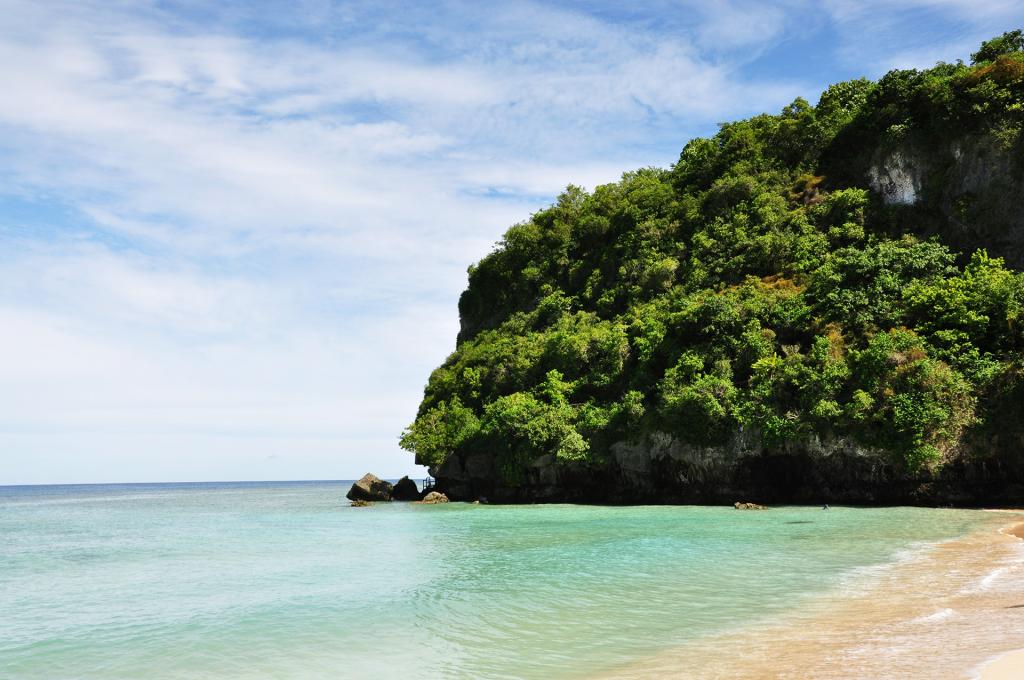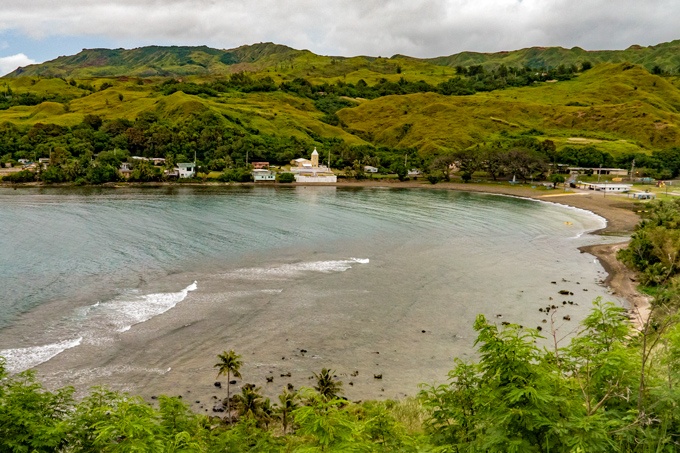Among history buffs, Guam is famous not for its glittering beaches and luxury shopping, but for its role in the Pacific WWII battles between the Allied forces and Japan. Just four hours after the attack on Pearl Harbor, Japanese planes attacked Guam, marking the start of an invasion that lasted until the Battle of Guam in 1944. After weeks of fighting, the U.S. recaptured Guam at the expense of 7,000 American and 17,500 Japanese lives.
Today, the jungles and beaches of brutal combat are eerily serene. Starting in Tumon, you can spend a day visiting pillboxes and guns hidden in the jungle-flanked cliffs, peering into Japanese tunnel systems, and touring two excellent museums devoted to Guam’s military history. Follow our guide to experience WWII in one day…
TUMON BEACH PILLBOXES

Take advantage of Guam’s cool mornings by starting your day walking the length of Tumon Beach. There are several Japanese pillboxes scattered on the water’s edge from Ypao Beach to the craggy bluffs beneath the Hotel Nikko. These fortifications were built as part of the Japanese defensive, but because American forces landed farther south, they were never tested. Today, beachgoers simply sunbathe beside them.
ASAN BAY OVERLOOK

Continue up Route 6 to visit the Asan Bay Overlook. This windblown site offers an aerial view of Asan Beach, also known as Invasion Beach. Some of Guam’s fiercest fighting took place on these sprawling cliffs and hillsides below. From here Japanese commanders launched a large but unsuccessful attack early the morning of July 26 in a final effort to push back Americans forces. Today, you’ll also find a memorial wall with the names of fallen American servicemen and Chamorro people who died during the Japanese occupation.
ASAN BEACH

This tranquil beach is the site of the initial landing of American marines in the Battle for Guam on July 21, 1944. By the day’s end, Asan and Agat (to the south) were both secured. Two torpedoes mark the entrance to memorialize the sacrifice of submariners. At the tip of the point is the Liberator’s Memorial, erected on the 50th anniversary of the Liberation of Guam to honor all U.S. forces involved in the recapture. If you choose to walk the Asan Ridge trail, you’ll encounter pillboxes, caves, and tunnels.
PITI GUNS UNIT

In the dense jungle above Piti, you’ll find three Japanese 140mm coastal defense guns stacked quietly alongside a steep ¾ mile trail. The trailhead is located behind the Our Lady of Assumption Church. Chamorro slave labor was used to haul and install the guns at the site, but the weapons were never fired. Today, they are the only guns on the entire island that remain in their original locations. The trail is well maintained, but can be slippery after a rain.
WAR IN THE PACIFIC NATIONAL HISTORICAL PARK MUSEUM

Just outside the entrance to the naval base is the headquarters of the War in the Pacific National Historical Park. At its entrance is a 78-foot long Japanese submarine that ran aground in August 1944. Inside, museum displays detail Guam’s colonial history, the Japanese occupation, and a the day-by-day American recapture of the island. There’s also an excellent gift shop with relevant books, brochures, and souvenirs. Open Tuesday through Saturday from 9:00 a.m. to 4:00 p.m.
AGAT BEACH

Agat was the second landing site of the southern assault for U.S. forces. The initial goals of the American campaign were to secure the Fonte Plateau and the Orote Peninsula, which held a crucial airfield. Today, the site is peaceful and still. There’s a 20cm short barrel naval gun and a 25mm double-barreled anti-aircraft machine gun at the beachside memorial. A quick walk along its adjacent trails reveals the bunkers and caves used by Japanese defenders, as well as panoramic views of the Orote Peninsula and Mt. Alifan.
YOKOI’S CAVE

Shoichi Yokoi was a Japanese soldier who spent nearly three decades hiding in the jungle, unaware that the war had ended. His hideout, known as Yokoi’s Cave, is in Talofofo Falls Park ($15 for non-residents). This site is a replica of the original cave that is located a few miles away in Bubualo, which has since collapsed. A gondola ride over the waterfalls drops you off at a signed trail that eventually leads to his underground shelter. Today, his cave is protected by a fence, but there’s a nearby above-ground reproduction that shows a profile of the 9×3 ft. bamboo-lined hiding place. After his discovery in 1972, Yokoi returned to Japan as a hero and eventually married. Before his 1997 death, he reportedly vacationed in Guam several times.
GUN BEACH

You’ll probably be feeling a bit heavy by the time you return to Tumon. Unwind at Gun Beach, where you can enjoy a fruity tropical drink at The Beach, Guam’s largest beach bar. Next, stroll down to the north end of the beach to visit one last historical site: another Japanese coastal gun. After the Battle for Guam, the war was just over a year away from ending. It’s oddly jarring to see the weapon juxtaposed alongside sun-drunk beachgoers, but there’s something moving in its close proximity to modern life. The Battle for Guam was brutal and bloody and should never be forgotten, and its tangible relics can still be touched—and touch us—today.











